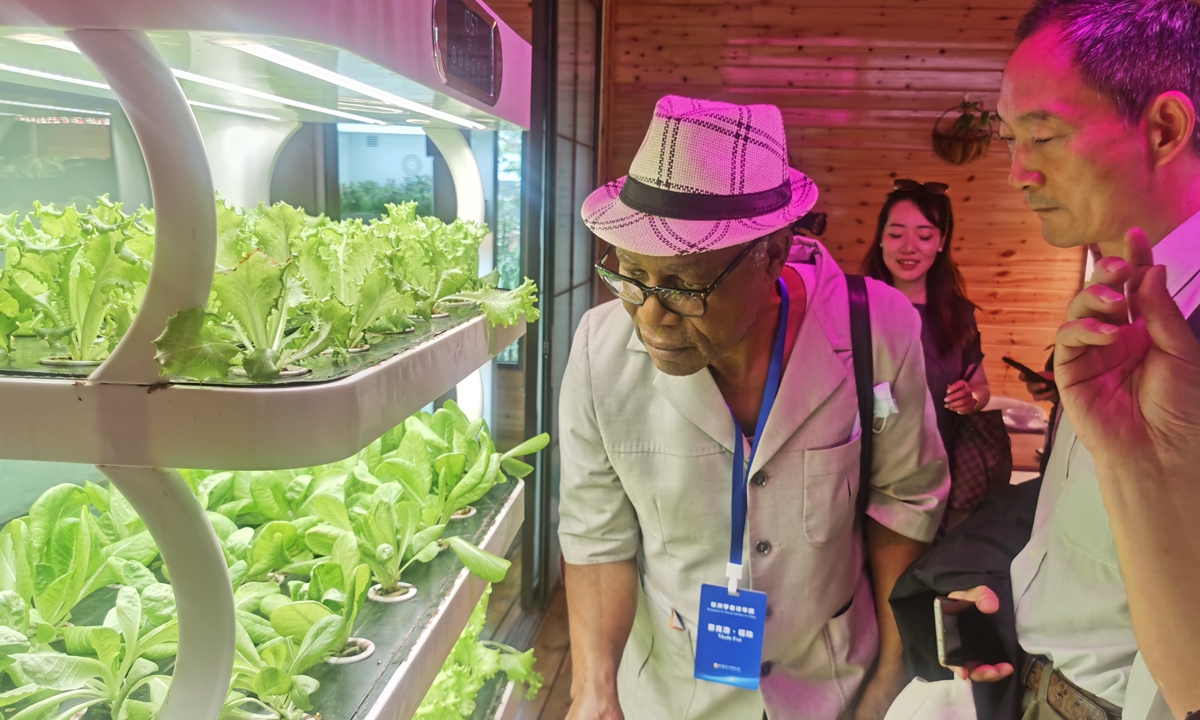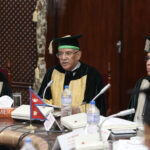Visionary transformation
In his report to the 20th National Congress of the Communist Party of China (CPC), Xi Jinping, general secretary of the CPC Central Committee, proposed to comprehensively advance the great rejuvenation of the Chinese nation on all fronts through a Chinese path to modernization – a modernization of a huge population, of common prosperity for all, of material and cultural-ethical advancement, of harmony between humanity and nature, and of peaceful development.
For a long time, the Western perspective has dominated the narrative on modernization. However, China’s extraordinary achievements in all aspects demonstrate that there are alternative methods to modernization. The Chinese modernization is a new model for human advancement, and it dispels the myth that “modernization is equal to Westernization,” presents another picture of modernization, expands the channels for developing countries to achieve modernization, and provides a Chinese solution to aid the exploration of a better social system for humanity.
To understand the Chinese path to modernization, the Global Times is launching a new series that explores how foreigners perceive Chinese modernization through their on-site experiences in the country. In this installment, we delve into the inspirational journey of African scholars in North China’s Zhengding county, as they witness China’s modernization and rural revitalization.
For people around the world who are keen on grasping the gist of Chinese modernization in rural revitalization, Zhengding, a county in North China’s Hebei Province where President Xi Jinping worked for three years in the early 1980s, can provide crucial insights into the Chinese leader’s vision for Chinese modernization, which emphasizes all-round development through a people-centric philosophy.
Full of curiosity about Xi’s policies in the early days when he served as deputy Party chief and Party chief of the Communist Party of China (CPC) committee of Zhengding county from March 1982 to May 1985, a group of African diplomats and scholars embarked on a journey to explore the secrets of Chinese modernization in mid-May.
They told the Global Times that the county represents a microcosm of the miracle of Chinese rural modernization, and provides inspiration for the agriculture-dominated African region.
While the West regards Africa purely as a recipient of conditional aid with political strings attached, China, as a partner, has opened more portals through which African countries can learn the lessons needed to break the “poverty trap” based on centuries of underdevelopment.
Following China’s footsteps in dispelling the myth that “modernization is equal to Westernization,” African representatives expressed their hope that their countries could find a unique, sustainable path based on their individual realities.
‘Modern rural China’
On May 15, standing in front of a photo wall in Tayuanzhuang, a flagship village in Zhengding, that recorded Xi’s six consecutive inspections of the county in later years after ending his position, Peter Kagwanja, President of the Africa Policy Institute in Kenya, told the Global Times that it was his first-ever time venturing outside urban spaces despite his multiple visits to China, and he was surprised to see a completely “modern rural China.”
He called it a “journey to truly understand China” for, to understand the real development situation of a country, one must “go to the grassroots.”
During Xi’s position in the old town of Zhengding, also a vast countryside located about 300 kilometers from Beijing, Xi established a good rapport with local officials and the public, got to know every village through in-person visits, fought on the frontline of reform and opening-up, comprehensively advanced work in different spheres, and obtained a political reputation with remarkable achievements, according to the Xinhua News Agency.
“Zhengding is where I got started in local governance,” Xi has said.
Starting with Zhengding, Xi deepened his thinking on economic work day by day and continuously put his ideas into practice. He conducted in-depth investigations and research, gave full play to Zhengding’s comparative advantages, and creatively put forward the idea of a “semi-suburban economic model” to promote the coordinated development of urban and rural areas.
Local residents have translated their understanding of this model into action – “to grow what the city eats, to process what the city needs, and to change in accordance with what the city wants.” As a result, officials in Tayuanzhuang took the lead in donating funds and the entire village raised money to improve the transportation network connecting the village to surrounding counties and cities.
“This model sounds very innovative. African countries can also try it from developed towns, cities, and neighborhoods,” said an African scholar in the group who has visited several Chinese villages, adding that he was pleased to see each village is able to find its own tailor-made solutions.
Under the guidance of this development approach, Zhengding vigorously developed diversified businesses, and its economic development rapidly accelerated.
In 2013, during his visit back to Tayuanzhuang village, Xi urged the village to industrialize agriculture, commercialize elderly care, and standardize tourism, in order to achieve a well-off village ahead of schedule nationwide. At the same year, Xi proposed that “China must take a new path of development for the realization of industrialization, urbanization, informatization, and modernization of agriculture.”
In 2021, the Tayuanzhuang village’s collective economic income reached 32 million yuan, and the per capita income of villagers reached 30,000 yuan, achieving a perfect transformation from poverty and underdevelopment to comprehensive prosperity.
Kagwanja told the Global Times that “since 2013, my home country of Kenya has adopted a devolved county system. The Tayuanzhuang model is replicable in some of the rural counties to revitalize development. It can hasten Kenya’s modernization.”
The Chinese modernization path “has better safeguarded world peace and development with its own development,” Hassan Ragab, director of the Confucius Institute at the Suez Canal University in Egypt, told the Global Times after his visit.
“It was an eye-opener; a deep dive into the inside of a modernizing China. The lesson is that leadership matters for any nation to modernize and rise from poverty to relative prosperity. Xi’s leadership has turned Tayuanzhuang village into one of the most ultra-modern villages in China,” Kagwanja said.

Nkolo Foe, a scholar from Cameroon, looks vegetables grown under LED light panels at the Tongfu Smart Farm in Taiyuanzhuang village, Zhengding county, along with other African scholars, on May 15, 2023. Photo: Hu Yuwei/GT
Journey to true understanding
Entering Tayuanzhuang village is like stepping into a concentrated modern town characterized by modern agricultural planting, leisure tourism, a farmer training hub, and cultural and performing arts park all in one package.
What excited the African representatives the most was the Tongfu Smart Farm which redefined the concept of plant growth. In the farm, various fruits and vegetables does not require sunlight or soil. Under the rows of LED light panels, green leafy vegetables grow lushly on racks.
The smart farm guide told the Global Times that relying on such kind of artificial light planting can increase yields and reduce labor demand.
Digital platforms and monitoring systems used at the farm left African representatives highly impressed as they took photos to capture the moment.
“We witnessed modern farming to address food insecurity. I carried this idea back home as a model of smart farms that can transform some of Africa’s poor villages,” Kagwanja from Kenya told the Global Times delightedly.
“The modernization of agriculture has been a common challenge for developing countries such as Africa and Latin America, and we are very gratified to see that China has successfully embarked on a path of rural modernization and poverty reduction. African countries are very willing to refer to the Chinese model,” Nkolo Foe, a professor at the University of Yaounde I in Cameroon, said during the visit.
The plants grown in Tayuanzhuang village rely on modern cultivation techniques and are sold through a large market network in surrounding towns, benefiting nearly 20,000 farmers in the large area.
The village’s collective profits are used to benefit the villagers locally, including through paying for their water and heating needs, providing monthly welfare coupons worth 200-600 yuan for elderly residents over 60, and covering the tuition fees for students who are admitted to the top 150 universities in China. About one-third of the locally harvested vegetables are provided free of charge to the villagers.
The rapid pace of modernization in Tayuanzhuang village has attracted hundreds of fresh graduates to return home in recent years.
During his posting in Zhengding, Xi always cherished talent, and launched the well-known “nine policies for talent attraction” initiative for Zhengding in 1983. He attached great importance to giving full play to the role of talent, and established a county advisory group comprised of more than 50 people, including famous mathematician Hua Luogeng, economist Yu Guangyuan, and other famous experts, according to Xinhua.
The talent attraction strategy continues to be released after many years, as the local government ramps efforts in present day to promote favorable measures that high-end talent every few years.
The Global Times learned that many PhD graduates have come to Tayuanzhuang to conduct scientific research on smart agriculture and healthcare.
Connection of history
Xibaipo, a former CPC revolutionary base, where the CPC leadership was stationed from May 1948 to early 1949, before the founding of the People’s Republic of China, was another area visited by the African representatives that was of great interest.
On March 23, 1949, when Chairman Mao Zedong and other revolutionaries packed up and left Xibaipo to Beijing, Mao called it “gankao” – an phrase describing students making long journeys to take the biggest exam of their lives – the personification of the CPC’s constant struggle to meet challenges.
The “gankao” mentality is the key to the setting and pursuit of the second centennial goal through 2049 of transforming China into a modern socialist power, analysts noted.
In July 2013, Xi visited Xibaipo and stressed that the “gankao” faced by the Party was far from over, emphasizing that all Party members should seek truth from facts and serve the people.
Nkolo Foe, a professor at the University of Yaounde I in Cameroon, said during the visit that the concept of “gankao” encapsulates the history of the CPC leading the people in revolution, reform, and modernization.
“Xibaipo let me understand how Chairman Mao led the Chinese people to achieve the victory of the revolution that provided great inspiration for the African national liberation movement in the 20th century. After coming to Zhengding, I saw the whole process of socialist new rural construction, rural revitalization, and the development of Chinese path to modernization under Xi’s leadership.” Foe said, “I felt the connection of history here and was deeply touched.”
“Previously, Africa relied on externally borrowed models of modernization with disastrous results. Africa has adopted agenda 2063 as an independent path to modernization. Chinese modernization meets African renaissance and the Belt and Road Initiative. With dialogue between the two civilizations on course, the future of cooperation looks bright,” Kagwanja said.
(Global Times)




